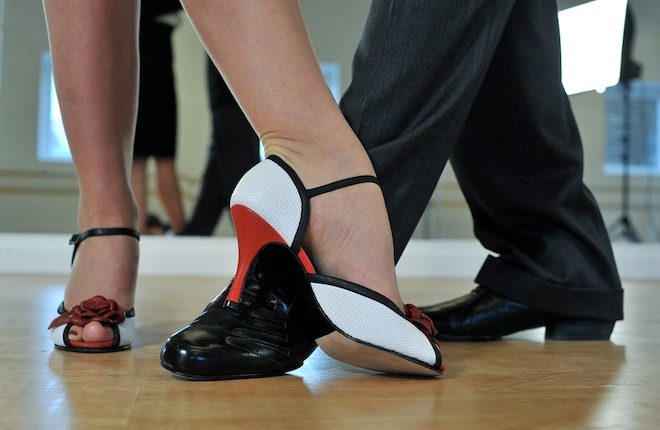I’m currently sitting with my leg up on a box icing a stress fracture in my left foot. I spend most of my day writing, but as soon as the workday is over, I’m out the door and headed to the studio to clock one to four hours of rehearsal. That’s almost fifteen hours a week, and while any company dancer would put me to shame, it’s still a rigorous program.
I’m a ballroom and latin dancer, and I’m never without my heels. Even my practice shoes carry a lift, though it’s lower than the three inches I compete and perform in. I don’t usually experience the same splits and blisters that modern dancers face, nor do I share struggles with ballet dancers and their beautiful pointe shoes, but heels bring their own set of challenges.
After years in heels, my feet are starting to show the wear. I’ve been through shin splints, ankle sprains, stress fractures, and just plain achiness. Each time, I learn something new, and over the years I’ve developed four cardinal habits to take care of the inner works of my most important asset — my feet.

1. Maintain Good Habits Off the Floor
Outside of dance, avoid constantly wearing heels or shoes that stress your feet. They’re special occasion shoes for a reason. Heels put stress on the delicate bones of the forefoot, rather than evenly distributing weight throughout the foot. You may gain some stability in lateral movement through your ankle joint, but it comes at the cost of strength in the muscles running in front and behind your ankle — in other words, your relevé muscles.
Flat shoes can be just as harmful if they don’t have arch support or padding along the sole. It may not feel like it, but you are slowly changing the stress points in your foot. To compromise on price and keep your feet happy, find insoles that work well for you and trim them to fit otherwise-structureless flats. I swap my insoles between summer and winter shoes to cut down on the total number I need.
2. Prioritize Quality Equipment
If your shoes are important off the floor, they’re even more important on the floor. Arguably, a dancer’s feet are their most important and utilized tools, which means that shoes have the ability to make or break your dancing. Few people have an endless budget, but when it comes to taking care of your feet, it’s often worth shelling out for a shoe that does its job.
Get to know your foot shape and understand how that impacts the shape of your shoe. Every brand is a little different, and each style serves a different purpose. Try on as many pairs as necessary to find one that works for your foot.
Be kind to your feet when breaking in shoes. If possible, buy new shoes a little before your old ones are truly at the end of their life so that you can switch back and forth. I often dance fundamentals in my new shoes and then change into shoes that I’m more comfortable with during challenging combinations or doing endurance work. This helps minimize blisters and stress points during the transition, as well as reduce the chance of injury (as long as there’s nothing structurally wrong with your old shoes).
3. Always Warm Up
There are 26 bones in your foot, plus all the musculature and tendons required to provide movement and stability. That’s a lot of moving parts! For your feet to function correctly and to reduce the likelihood of injury, it’s important to adequately warm the structures before placing them under high levels of stress.
Develop or adopt a routine that you work through before every class, show, or practice session. Having a set series will create consistency, and also allow you to note discrepancies or aches from day to day. You should include movements that work through your full range of motion as well as some massage techniques or light resistance band movements.
On off days when I won’t be dancing, I do my warm up and follow it with a foot and ankle strengthening routine to supplement my dancing. I’ll often incorporate more involved resistance band movements and take time to stretch more thoroughly.
4. Don’t Push Through Pain
Dance is hard on the body, and that makes overuse injuries, strains, and sprains abundant. If you dance en pointe or in heels, the lower limbs have more potential for injury, especially if the proper alignment is lacking.
Your entire body rests on your feet, so any injury to these important pillars can travel up the leg and affect the knee, ankle, hip, or your posture as a whole. While it’s tempting to dance through the pain, you may be compensating for injuries even if you don’t think you are, and that can cause muscular imbalances or problems in the way your foot functions.
When you have persistent pain, make an appointment with your provider. I prefer to see a chiropractor, podiatrist, or physical therapist over an MD as for their experience with biomechanics. While you’re waiting for your appointment, you don’t need to cease activity entirely, but it is important to not make things worse. Stay active using movements that don’t aggravate your injury.
Once you receive your provider’s diagnosis and care plan, it’s important to follow it to the letter. Rest when you’re told to, perform any exercises given, and take recommended supplements to help your body heal. For the most part, unless otherwise instructed by a doctor, my propensity is to utilize natural anti-inflammatories to manage symptoms rather than relying on ibuprofen or acetaminophen to hide pain. Keeping these in your diet regularly will also aid in recovery time and minimizing inflammation injuries like bursitis or tendonitis.
Trust Your Body
The drive to move and dance can make it difficult to sit still long enough to heal. You don’t want to miss out on parts, performances, or even just technique class, but it’s important to provide your body with adequate rest, especially when it comes to your feet. Your body developed sensitivity to pain and warning mechanisms for a reason, and occasionally rest is necessary. Trust the system your body uses, and take care of the parts you can. That way, you’ll spend more time dancing and less time recovering!
 Alyssa Robinson is a lover of words and movement who happily resides in the Pacific Northwest. She started dancing at 19 when the ballroom (and latin) bug bit her, and she hasn’t stopped since. If she’s not writing about food, fitness, and dance, she’s in the studio training for her next ballroom competition.
Alyssa Robinson is a lover of words and movement who happily resides in the Pacific Northwest. She started dancing at 19 when the ballroom (and latin) bug bit her, and she hasn’t stopped since. If she’s not writing about food, fitness, and dance, she’s in the studio training for her next ballroom competition.
NO information on this site should be used to diagnose, treat, prevent or cure any disease or condition. By reading this website, you acknowledge that you are responsible for your own health decisions. Always seek the advice of your physician or other qualified health care provider with any questions you may have regarding a medical condition. Learn more about this website and its policies here.

Dance Advantage welcomes guest posts from other dance teachers, students, parents, professionals, or those knowledgeable in related fields. If you are interested in having your article published at Dance Advantage, please see the following info on submitting a guest post. Read posts from guest contributors.

